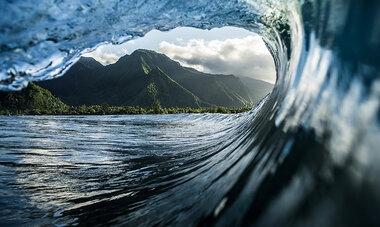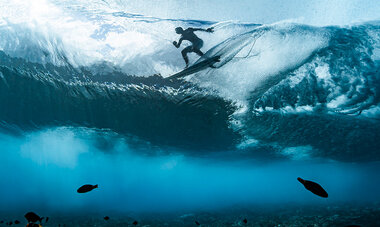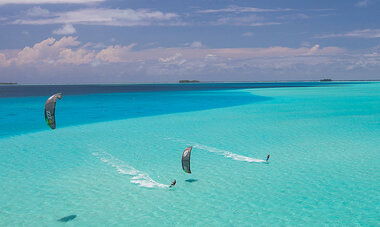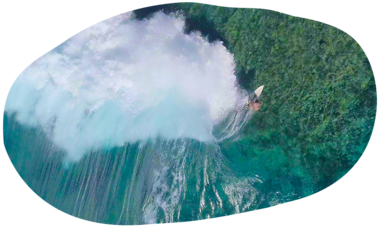
The ultimate Tahiti surf guide: best spots, travel tips and more
Even though common surfing terms such as reef, beach, shore break, blowy, windy, swell often come from the English language, it is in Tahiti that surf was described for the first time. In the Islands of Tahiti, surfing is more than a sport: it’s a lifestyle…
Big names such as Kauli Vaast, Vahine Fierro, Michel Bourez and Raimana Van Bastolaer learned here. And many top international athletes like Kelly Slater know the place by heart.
In French Polynesia, waves are everywhere. However, it is worth finding the surf spots mostly known by the locals. Whether you're a beginner or an experienced surfer on a trip to Tahiti, we've got you covered. Learn all about the beaches in Tahiti, and experience the thrills and spills of discovering an Olympic games wave and surfing on the other side of the world!

The best surf spots in Tahiti
The first written records about this majestic water sport dates back to 1769 in Tahiti, in Joseph Banks writings* (see bottom of page), naturalist of the James Cook's expedition. The paternity of surfing goes to the Polynesians. Its development too, in Hawaii this time, revitalized by American-style marketing. But at the dawn of the 2024 Olympics (held in July and August 2024) and international competitions, Tahiti is in the spotlight with “Teahupo'o”, its legendary wave.
Teahupo'o is Tahiti's best surf spot if you want to watch the surfers perform. From sunrise to sunset, the local “taxi boats” departing from the small village, will take you close to this famous wave where you can watch the locals in action. This is the home of great Polynesian athletes such as Michel Bourez, Vahine Fierro and Kauli Vaast.
Even if you missed the Olympic games, try to visit Teahupo'o during a competition day to see stunning performances and capture breathtaking images from your taxi boat. These events attract people from all over the world (metropolitan France, Los Angeles, Australia, Japan...) and create a real community around a common passion. You may be lucky enough to see some of the top international athletes who come to Tahiti to train or compete in the world championships every year.
Before trying to surf this mythical left break, here is a tour of the most accessible surf spots on the island of Tahiti, which we have listed for you, from north to south from the capital of Tahiti, Papeete. Enjoy your surf trip in French Polynesia !
Punaauia
Let's get away from the Paris 2024 Olympics wave and discover Tahiti's other surfing spots. Surfers enjoy two amazing left reef breaks in Punaauia, on the West Coast of Tahiti: Taapuna and Sapinus. There, the English contemplated the Oropa’a (a group of residents of Punaauia) surfing waves in 1769.
Papara
Again, two amazing waves, left and right breaks, close to the Mara pass, also where the caves and the Taharu’u spot are located.
The Taharu’u, at the mouth of the river is a perfect wave to learn to surf with an easy and safe access. It is the advantage of any waves located on a river’s mouth. Whether you are on a surf trip or just visiting Tahiti, stop by this beach to enjoy the typical French Polynesian atmosphere and watch the surfers practice.
Tahiti Peninsula (Presqu’île)
Once on the Presqu’île, toward Teahupo’o, we enjoy three beautiful reef waves Te Ava Ino (left), Te Ava Iti (right) and the very well-known Vairao (long left).
The legendary and Olympic massive left-hand wave of Teahupo’o is at PK 0, breaking only a few hundred meters offshore, and is reserved for the most experienced surfers. Athletes from all over the world gather here for competitions or for unique surf trips on one of the most famous waves in the world.
When the sea is too rough, a less famous wave at the river mouth allows easier surfing.
East Coast
When going to the North of Tahiti Nui, Faa’one pass offers a nice right reef break, and another one on the river mouth. The spot is well known for its beautiful wind wave.
Papeno’o surfing spot
The Papeno’o river mouth and the spot of the Papeno’o’s bay is ideal for beginners: it offers pebbles, sand, and plenty of space for surfing.
In the same area, locals know the surf spots of Papeno’o’s spring and Rocky Point (PK 15), a great left-right break.
At the « Trois-Sapins » spot, swap your surf for a bodyboard: waves break very close to the shore.
North Coast
Facing North, the Orofara site has many river mouth accesses, as well as a spring, but the front side left and right break is the actual beach spot. In Mahina, the Ahonu spot is a surfing school by itself. When the weather is rough, waves are impressive, but it is usually a good spot for beginners, with water up to the waist.
When it gets really busy, priority is given to the youngest surfers who are still learning.
From Pointe Vénus to Papeete
At Pointe Vénus, the right break is a dangerous wave as it is shallow, not like the Pointe Vénus’ beach, and its right and left perfect breaks for beginners: they can go a little bit high but there isn’t any current or tide, and there are very secure series of 3-4 waves.
The Lafayette reef in Arue is a right break for surfers and bodyboarders. The latter also enjoy the Lafayette beach break.
So, North or South?
The North Coast of Tahiti, from Arue to Hitia’a O te Ra is very popular with local surfers and visitors on a surf trip, the Northern swell getting bigger mainly from November to April-May, pick of the season.
But be aware that it is also the To’erau season, a Northern wind bringing rain. With this heavy rain, rivers carry soil and germs: no surfing if you have open wounds.
In Tahiti the swell from South is all year long, but it is more intense between April and September-October, anywhere in the Pacific.
It is also the Mara’amu wind season (South-East wind). Currents are stronger, floors are changing, waves increase or break hard, choppy waters affect the visibility. Caution and a good selection of surf spots is essential, depending on the wave’s orientations.
If the ocean and waves are for everyone, going to a spot that is used by its regulars is an act of respect and sharing. Do not hesitate to contact local surfers as their knowledge of the surf spots is precious. When the sea is too rough, they meet on retreat spots that we didn’t indicate here as you’ll discover them with locals. This is also the spirit of surfing.

Moorea Surfing Spots
Called Tahiti’s Sister Island, due to its proximity to Tahiti, Moorea also offers world-class surfing spots for your trip in French Polynesia.
From the ferries’ terminal in Vaiare bay, let’s go North for an Island tour of the best waves.
The North Coast from Temae to Hauru
Facing the island of Tahiti, Temae is a beautiful right break. Very unique and not easy to surf, it breaks directly on the reef top (same as Avatoru in Rangiroa). The best surfers from all around the World have come to get challenged.
Cook Bay. Pao Pao reef is a great left break on Teavarua pass. Most of the time it is not impressive, but when it gets bigger, the wave’s barrel can be seen from the road far down the bay. It is one of the most beautiful waves of Moorea, with Haapiti’s.
In ‘Opunohu bay, when entering the bay, two great waves are interesting in the Tareu pass. The right is a regular break, the left can only be surfed when the swell is big, and it comes from the North.
Before Pointe Hauru, the Park Royal spot (named after the former hotel that preceded the Intercontinental Moorea), at the Taotai (Totara) pass — sometimes spelled Taotoi — offers a well-liked left-hand wave, popular among intermediate to advanced surfers.
The West Coast
Haapiti is THE spot for many surfers of Moorea. The left-hand wave at the Taotaha pass is world-class. In Atiha bay, a beautiful left and right break comes from Avarapa pass.
Tahiti and Moorea offer many awesome surfing spots enjoyed by around-the world surfers in renowned competitions and events.


Bora Bora surfing spots
Bora Bora is just a one hour flight away from Tahiti. With its only pass and its lagoon protected by the reef, the Pearl of the Pacific will not be the right spot for surfing. Your preferred hobby can be put aside while taking advantage of the beautiful island’s various attractions.
If you still miss riding, take the opportunity to try wing foil on a lagoon as wide as an inland sea, with the friendly assistance of the wind.
Think about introducing some ecstatic relaxation time to your schedule: don’t forget, you’re in Paradise!

Rangiroa’s surfing spots
Have you ever heard about the Rangiroa Pro Surf? This competition, also call Ra’iroa hōrue in Tahiti, used to happen every year in Avatoru Pass until 2020.
This surfing spot comes with a beautiful and magical right break. On this atoll, The landscape is very different from that of Tahiti or Moorea, offering you a unique experience. Here run regular series of more than 2 meters high barrel’s waves. Be careful, the coral reef is close and easy to scratch if you go too deep.

Tikehau surfing spots
300 km from Tahiti and not far from Rangiroa, Tikehau is another beautiful atoll. This spot isn’t suitable for everyone. As it is pretty dangerous, this left reef break in the Tuhei pass (Tuheiava in reo mā’ohi) is very strong, it is better to know about it: it has shallow water and a large barrel. It is formed by a South-West swell. Access it by rowing (Paddle board, Kayak) or with a motorized engine (boat, jet ski).
Our tips for surfing in The Islands of Tahiti
Standing on a surfboard, you'll experience Polynesia's deep connection to the ocean. Here's what you need to know before you start your trip.
Learning to surf in Tahiti
If you're a beginner and want to learn how to surf safely, contact a Polynesian surf school, which offers beginners and advanced courses. Your instructor will guide you to beaches with small waves and the best conditions to learn.
Surfing equipment
If you're taking a course, your surf school will provide you with the appropriate equipment. Some surf schools also rent out boards.
If you're an experienced surfer, remember to pack your own board for the surf trip of your dreams! Air Tahiti Nui offers free transport of your surfboard, longboard, bodyboard, paddle board (SUP) and kitesurf within the weight and size limits allowed in the hold for special baggage.
When is the best time to surf in The Islands of Tahiti?
You can surf all year round in Tahiti! The best period for experienced surfers is the mild season (summer), between May and September, which offers big waves and ideal weather conditions with plenty of sunshine. It is also the Mara’amu wind season (South-East wind). Currents are stronger, floors are changing, waves increase or break hard, and choppy waters affect visibility. Caution and a good selection of surf spots are essential, depending on the wave’s orientations.
The rest of the year, between November and early April, Tahiti's southern surf spots offer better conditions for less experienced surfers, and the north of the island provides great waves.
“In our return to the boat we saw the Indians** amuse or exercise themselves in a manner truly surprising. It was in a place where the shore was not guarded by a reef as is usually the case, consequently a high surf fell upon the shore, a more dreadful one I have not often seen: no European boat could have landed in it and I think no European who had by any means got into [it] could possibly have saved his life as the shore was covered with pebbles and large stones.
In the midst of these breakers 10 or 12 Indians were swimming who whenever a surf broke near them dived under it with infinite ease, rising up on the other side ; but their chief amusement was carried on by the stern of an old canoe, with this before them they swam out (8) as far as the outermost breach, then one or two would get into it and opposing the blunt end to the breaking wave were hurried in with incredible swiftness.
Sometimes they were carried almost ashore but generally the wave broke over them before they were halfway, in which case the[y] dived and quickly rose on the other side with the canoe in their hands, which was towed/(swam) out again and the same method repeated.”
* May 28, 1769, Volume 1, pp. 258-259
** Local Tahitians